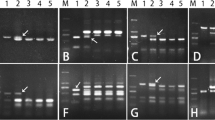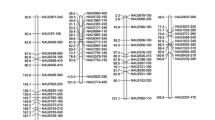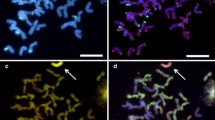Abstract
Allium roylei was employed for the production of alien chromosome addition lines in A. fistulosum. Interspecific hybridization between A. fistulosum and A. roylei successfully produced F1 hybrids. Chromosome doubling of an F1 hybrid was carried out to produce amphidiploids. After two times backcrossing of the amphidiploids with A. fistulosum, a BC2 generation was obtained with chromosome numbers (2n) ranging from 16 to 23. Alien monosomic addition lines (AMAL, FF + nR, 2n = 17) appeared with the highest frequency. Furthermore, multiple addition lines (MAL, 2n = 18–23) were also observed with lower frequencies. Five AMALs (FF + 1R, +3R, +4R, +5R, and +8R) and ten MALs (2n = 18–23) were characterized using isozyme and DNA markers. The extra chromosomes from A. roylei clearly altered the biochemical characteristics of the MALs. Variations in sugar, cysteine sulfoxide, and flavonoid contents were observed among the MALs in various amounts. Allium fistulosum–A. roylei allotriploids (2n = 24, FFR) showed significantly higher saponin content and antifungal activities of saponin extracts against isolates of Fusarium oxysporum f. sp. cepae in comparison with A. fistulosum. This first report of A. fistulosum–A. roylei addition lines opens the possibility of developing novel A. fistulosum cultivars with enhanced nutritional value and disease resistance.







Similar content being viewed by others
References
Block E (2010) Garlic and other Alliums the lore and the science. RSC Publishing, UK
De Vries JN (1990) Onion chromosome nomenclature and homoeology relationship-workshop report. Euphytica 49(1):1–3
De Vries JN, Wietsma WA, De Vries T (1992) Introgression of leaf blight resistance from Allium roylei Stearn into onion (A. cepa L.). Euphytica 62(2):127–133
Dissanayake MLMC, Kashima R, Tanaka S, Ito S-I (2009) Pathogenic variation and molecular characterization of Fusarium species isolated from wilted Welsh onion in Japan. J Gen Plant Pathol 75(1):37–45
Ebrahimzadeh H, Niknam V (1998) A revised spectrophotometric method for determination of triterpenoid saponins. Indian Drugs 35(6):379–381
Galvan GA, Koning-Boucoiran CFS, Koopman WJM, Burger-Meijer K, Gonzalez PH, Waalwijk C, Kik C, Scholten OE (2008) Genetic variation among Fusarium isolates from onion, and resistance to Fusarium basal rot in related Allium species. Eur J Plant Pathol 121(4):499–512
Hang TTM, Shigyo M, Yamauchi N, Tashiro Y (2004) Production and characterization of alien chromosome additions in shallot (Allium cepa L. Aggregatum group) carrying extra chromosome(s) of Japanese bunching onion (A. fistulosum). Genes Genet Syst 79(5):263–269
Inden H, Asahira T (1990) Japanese bunching onion (Allium fistulosum L.). In: Brewster JL, Rabinowitch HD (eds) Onion and allied crops. Biochemistry, food science, and minor crops, vol 3. CRC Press, Boca Raton, pp 159–178
Kalkman ER (1984) Analysis of the C-banded karyotype of Allium cepa L. Standard system of nomenclature and polymorphism. Genetica 65:141–148
Khrustaleva LI, Kik C (1998) Cytogenetical studies in the bridge cross Allium cepa × (A. fistulosum × A. roylei). Theor Appl Genet 96:8–14
Khrustaleva LI, Kik C (2000) Introgression of Allium fistulosum into A. cepa mediated by A. roylei. Theor Appl Genet 100(1):17–26
Kik C (2002) Exploitation of wild relatives for the breeding of cultivated Allium species. In: Rabinowitch HD, Currah L (eds) Allium crop science: recent advances. CABI Publishing, Wallingford, pp 81–100
Masuzaki S, Shigyo M, Yamauchi N (2006a) Complete assignment of structural genes involved in flavonoid biosynthesis influencing bulb color to individual chromosomes of the shallot (Allium cepa L.). Genes Genet Syst 81(4):255–263
Masuzaki S, Araki N, Yamauchi N, Yamane N, Wako T, Kojima A, Shigyo M (2006b) Chromosomal locations of microsatellites in onion. HortScience 41(2):315–318
Maude RB (1990) Leaf diseases of onions. In: Brewster JL, Rabinowitch HD (eds) Onion and allied crops. Agronomy, biotic interactions, pathology, and crop protection, vol 2. CRC Press, Boca Raton, pp 173–190
McCallum J, Pither-Joyce M, Shaw M, Kenel F, Davis S, Butler R, Schever J, Jakse J, Havey MJ (2007) Genetic mapping of sulfur assimilation genes reveals a QTL for onion bulb pungency. Theor Appl Genet 114:815–822
McCollum GD (1982) Experimental hybrids between Allium fistulosum and A. roylei. Bot Gaz 143(2):238–242
Murashige T, Skoog F (1962) A revised medium for rapid growth and bio assays with tobacco tissue cultures. Physiol Plant 15:473–497
Scholten OE, Van Heusden AW, Khrustaleva LI, Burger-Meijer K, Mank RA, Antonise RGC, Harrewijin JL, Van Haecke W, Oost EH, Peters RJ, Kik C (2007) The long and winding road leading to the successful introgression of downy mildew resistance into onion. Euphytica 156:345–353
Shigyo M, Tashiro Y, Miyazaki S (1994) Chromosomal locations of glutamate oxaloacetate transaminase gene loci in Japanese bunching onion (Allium fistulosum L.) and shallot (A. cepa L. Aggregatum group). Jpn J Genet 69(4):417–424
Shigyo M, Tashiro Y, Isshiki S, Miyazaki S (1995) Chromosomal locations of five isozyme gene loci (Lap-1, Got-1, 6-Pgdh-2, Adh-1 and Gdh-1) in shallot (Allium cepa L. Aggregatum group). Jpn J Genet 70(3):399–407
Shigyo M, Iino M, Isshiki S, Tashiro Y (1997a) Morphological characteristics of a series of alien monosomic addition lines of Japanese bunching onion (Allium fistulosum L.) with extra chromosomes from shallot (A. cepa L. Aggregatum group). Genes Genet Syst 72(4):181–186
Shigyo M, Tashiro Y, Iino M, Terahara N, Ishimaru K, Isshiki S (1997b) Chromosomal locations of genes related to flavonoid and anthocyanin production in leaf sheath of shallot (Allium cepa L. Aggregatum group). Genes Genet Syst 72(3):149–152
Singh RJ (2003) Plant cytogenetics. CRC Press, Boca Raton
Tsukazaki H, Yamashita K, Yaguchi S, Masuzaki S, Fukuoka H, Yonemaru J, Kanamori H, Kono I, Hang TTM, Shigyo M, Kojima A, Wako T (2008) Construction of SSR-based chromosome map in bunching onion (Allium fistulosum). Theor Appl Genet 117(8):1213–1223
Van Heusden AW, van Ooijen JW, Vrielink-van Ginkel R, Verbeek WHJ, Wietsma WA, Kik C (2000a) A genetic map of an interspecific cross in Allium based on amplified fragment length polymorphism (AFLPTM) markers. Theor Appl Genet 100(1):118–126
Van Heusden AW, Shigyo M, Tashiro Y, Ginkel RV, Kik C (2000b) AFLP linkage group assignment to the chromosomes of Allium cepa L. via monosomic addition lines. Theor Appl Genet 100(3–4):480–486
Vu HQ, Iwata M, Yamauchi N, Shigyo M (2011) Production of novel alloplasmic male sterile lines in Allium cepa harbouring the cytoplasm from Allium roylei. Plant Breed 130(4):469–475
Vu HQ, Yoshimatsu Y, Khrustaleva LI, Yamauchi N, Shigyo M (2012) Alien genes introgression and development of alien monosomic addition lines from a threatened species, Allium roylei Stearn, to Allium cepa L. Theor Appl Genet 124(7):1241–1257
Vu HQ, Hang TTM, Yaguchi S, Ono Y, Pham TMP, Yamauchi N, Shigyo M (2013) Assessment of biochemical and antioxidant diversities in a shallot germplasm collection from Vietnam and its surrounding countries. Genet Resour Crop Evol. doi:10.1007/s10722-012-9920-9
Yaguchi S, McCallum J, Shaw M, Pither-Joyce M, Onodera S, Shiomi N, Yamauchi N, Shigyo M (2008) Biochemical and genetic analysis of carbohydrate accumulation in Allium cepa L. Plant Cell Physiol 49(5):730–739
Yaguchi S, Hang TTM, Tsukazaki H, Vu QH, Masuzaki S, Wako T, Masamura N, Onodera S, Shiomi N, Yamauchi N, Shigyo M (2009) Molecular and biochemical identification of alien chromosome additions in shallot (Allium cepa L. Aggregatum group) carrying extra chromosome(s) of bunching onion (A. fistulosum L.). Genes Genet Syst 84(1):43–55
Acknowledgments
The authors are very thankful to Dr. Shigenori Yaguchi from the Department of Food Science and Technology, National Fisheries University; Dr. Shin-ichi Masuzaki from Forensic Science Laboratory, Yamaguchi Prefectural Police Headquarters; Takane Furuta from Laboratory of Plant Chromosome and Gene Stock, Faculty of Science Hiroshima University and Tomoko Morita for their contribution to this study.
Author information
Authors and Affiliations
Corresponding author
Rights and permissions
About this article
Cite this article
Ariyanti, N.A., Hoa, V.Q., Khrustaleva, L.I. et al. Production and characterization of alien chromosome addition lines in Allium fistulosum carrying extra chromosomes of Allium roylei using molecular and cytogenetic analyses. Euphytica 206, 343–355 (2015). https://doi.org/10.1007/s10681-015-1476-2
Received:
Accepted:
Published:
Issue Date:
DOI: https://doi.org/10.1007/s10681-015-1476-2




